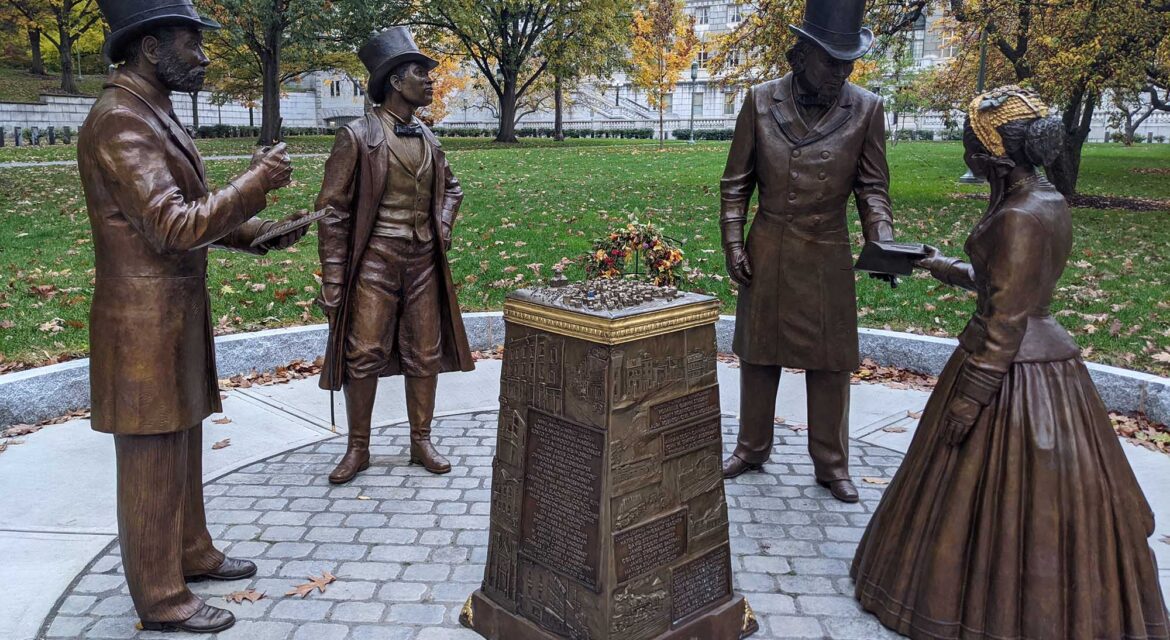 A Gathering at the Crossroads is a sculpture series that celebrates the anniversaries of the 15th and 19th amendments, which respectively provided African-Americans and women the right to vote. It also represents a neighborhood that previously resided in what is today the grounds of the State Capital in Harrisburg, Pennsylvania. In doing so, the piece is connected to the history of the area while also honoring a legacy that defines the community.
A Gathering at the Crossroads is a sculpture series that celebrates the anniversaries of the 15th and 19th amendments, which respectively provided African-Americans and women the right to vote. It also represents a neighborhood that previously resided in what is today the grounds of the State Capital in Harrisburg, Pennsylvania. In doing so, the piece is connected to the history of the area while also honoring a legacy that defines the community.

Celebrating the Commonwealth’s Legacy of Freedom
 Harrisburg’s Old 8th Ward once bordered the Capitol of the state of Pennsylvania. This area served as an incubator for advocacy during the years between the passage of the 15th and 19th amendments, which happened between 1870 and 1920. Orators would inspire the community to practice and fight for their right to vote in this predominantly African American and immigrant neighborhood.
Harrisburg’s Old 8th Ward once bordered the Capitol of the state of Pennsylvania. This area served as an incubator for advocacy during the years between the passage of the 15th and 19th amendments, which happened between 1870 and 1920. Orators would inspire the community to practice and fight for their right to vote in this predominantly African American and immigrant neighborhood.
This neighborhood would be partially displaced to make way for what is today the Capitol Complex. An extension in the mid-1900s wiped out the remaining blocks. This displacement would eventually lead to an effort led by a coalition of over 40 organizations and 200 individuals to memorialize and celebrate this history. It led to A Gathering at the Crossroads being installed in 2020.
Sculpted by Becky Ault, the sculpture series depicts a handful of the great orators who helped champion the changes brought on by the Amendments. Ms. Frances Ellen Watkins Harper, William Howard Day, Jacob Compton, and Thomas Morris Chester all lived or spoke in the Old 8th Ward.
As a further connection to the Old 8th Ward, family names are inscribed on the orator’s pedestal around which the four stand. These are the names of 100 prominent African-Americans who lived in Harrisburg in the late 19th and early 20th centuries. Names of change agents and history makers that served as the sponsors of the project are also incorporated into the piece.
This allegorical gathering allows audiences to literally engage with figures that greatly influenced the past and present of the community. Doing so has allowed A Gathering at the Crossroads to also define space in front of the capital that had previously been empty and unused, providing the community of a present with a connection to the past and future of the entire region.

Extending Freedoms to Everyone
 A Gathering at the Crossroads inspires discussion over how the country extended freedoms to all, regardless of race or gender. It also challenges visitors to think about the enduring history of voter suppression through 1920. The piece has cultivated discussions and conversations in a space that would otherwise be empty, showcasing what it can mean for a monument to create engagement and opportunity on multiple levels.
A Gathering at the Crossroads inspires discussion over how the country extended freedoms to all, regardless of race or gender. It also challenges visitors to think about the enduring history of voter suppression through 1920. The piece has cultivated discussions and conversations in a space that would otherwise be empty, showcasing what it can mean for a monument to create engagement and opportunity on multiple levels.

